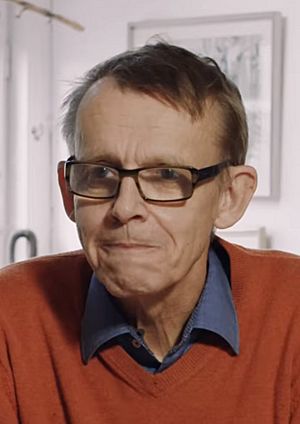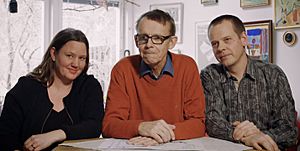Hans Rosling facts for kids
Quick facts for kids
Hans Rosling
|
|
|---|---|

Rosling in 2016
|
|
| Born | 27 July 1948 Uppsala, Sweden
|
| Died | 7 February 2017 (aged 68) Uppsala, Sweden
|
| Nationality | Swedish |
| Citizenship | Swedish |
| Alma mater | Uppsala University St. John's Medical College |
| Known for | Video lectures on global health |
| Spouse(s) |
Agneta Thordeman
(m. 1972, death) |
| Children | 3 (including Ola Rosling) |
| Awards | The World's 100 Most Influential People: 2012 Grierson Awards - Best Science Documentary: 2011 Honorary chieftainship - Liberia |
| Scientific career | |
| Institutions | Karolinska Institutet |
| Thesis | Cassava, Cyanide, and Epidemic Spastic Paraparesis: A Study in Mozambique on Dietary Cyanide Exposure (1986) |
Hans Rosling (27 July 1948 – 7 February 2017) was a Swedish doctor, professor, and public speaker. He was known for making complex global data easy to understand. He taught international health at the Karolinska Institute.
Hans Rosling also co-founded the Gapminder Foundation. This group created a special software called Trendalyzer. He gave many presentations, including famous TED Talks. In these talks, he used data and cool visuals to show how the world was changing. After he passed away, his book Factfulness became a worldwide bestseller. He wrote it with his son, Ola Rosling, and daughter-in-law, Anna Rosling Rönnlund.
| Top - 0-9 A B C D E F G H I J K L M N O P Q R S T U V W X Y Z |
Life and Early Career
Hans Rosling was born in Uppsala, Sweden, on 27 July 1948. From 1967 to 1974, he studied statistics and medicine at Uppsala University. In 1972, he also studied public health in Bangalore, India. He became a licensed doctor in 1976.
From 1979 to 1981, he worked as a District Medical Officer in Nacala, northern Mozambique. In 1981, he started looking into an outbreak of a disease called konzo. This disease causes paralysis. His research on konzo earned him a Ph.D. from Uppsala University in 1986. Hans Rosling also had dyslexia.
Sharing Knowledge Through TV
Rosling presented a TV show called The Joy of Stats in 2010. It was shown in the UK on BBC Four. He also presented Don't Panic — The Truth about Population in 2013. This show used a special 3D projection to display data. In 2015, he presented Don't Panic: How to End Poverty in 15 Years. This documentary aired before the UN's Sustainable Development Goals were announced.
Hans Rosling was also a sword swallower. He even showed this skill at a TED conference. In 2009, he was named one of the top 100 global thinkers by Foreign Policy magazine. In 2011, Fast Company listed him as one of the 100 most creative people in business. He became a member of important Swedish academies. In 2012, Time magazine included him in their list of the world's 100 most influential people.
Work in Global Health
Rosling spent 20 years studying outbreaks of konzo. This paralytic disease affected people in rural parts of Africa. He found that konzo happened when people were very hungry. They would eat cassava that wasn't prepared properly. This led to both poor nutrition and high levels of cyanide from the cassava.
Rosling's research also looked at how economic growth, farming, poverty, and health are connected. He worked as a consultant for the Swedish International Development Cooperation Agency (Sida). He advised them on health care and HIV programs. He also advised the World Health Organization and UNICEF. In 1993, he helped start Médecins Sans Frontières (Doctors Without Borders) in Sweden. At the Karolinska Institutet, he led the Division of International Health. He also helped start new courses on global health. He co-wrote a textbook that encouraged a fact-based view of the world.
Trendalyzer and Gapminder Foundation
Hans Rosling's son, Ola Rosling, created the Trendalyzer software. This program made data from the UN and World Bank come alive. It helped Hans explain global trends with moving graphics. Hans Rosling, his son Ola, and his daughter-in-law Anna Rosling Rönnlund started the Gapminder Foundation. Their goal was to use Trendalyzer to turn statistics into interactive visuals.
His presentations using Gapminder graphics became very famous. They helped people see how the world was developing. The interactive animations are free to use on the Gapminder Foundation's website. In 2007, Google bought the Trendalyzer software. They wanted to make it available to everyone. Later, Google released tools like the Motion Chart and the Public Data Explorer.
Personal Life and Passing
Hans Rosling faced several health challenges. When he was 20, doctors found an issue with his liver. At 29, he had cancer, which was successfully treated. Later, he was diagnosed with hepatitis C. This led to liver problems over time. In 2013, he began to experience liver failure. However, new medicines for hepatitis C became available. He spoke out about how expensive these new drugs were. He believed everyone with hepatitis C should get access to them.
In 2016, Hans Rosling was diagnosed with pancreatic cancer. He passed away from the disease on 7 February 2017.
Awards and Recognition
Hans Rosling received many awards for his work:
- 2006 – Enlightener of the Year from the Swedish Skeptics Association
- 2010 – The Gannon Award for the Continued Pursuit of Human Advancement (US)
- 2010 – Illis quorum medal
- 2012 – Listed in Time 100 as one of the most influential people
- 2012 – Harvard Humanitarian Award
- 2014 – Honorary Doctor at Uppsala University, Sweden
- 2014 – The Patron's Medal from the Royal Geographical Society of London
- 2017 – United Nations Population Award
Selected Publications
- Rosling, H.; Härgestam, F. (2020). How I Learned to Understand the World: A Memoir. Flatiron Books. p. 256. ISBN: 9781250266897
See also
 In Spanish: Hans Rosling para niños
In Spanish: Hans Rosling para niños


